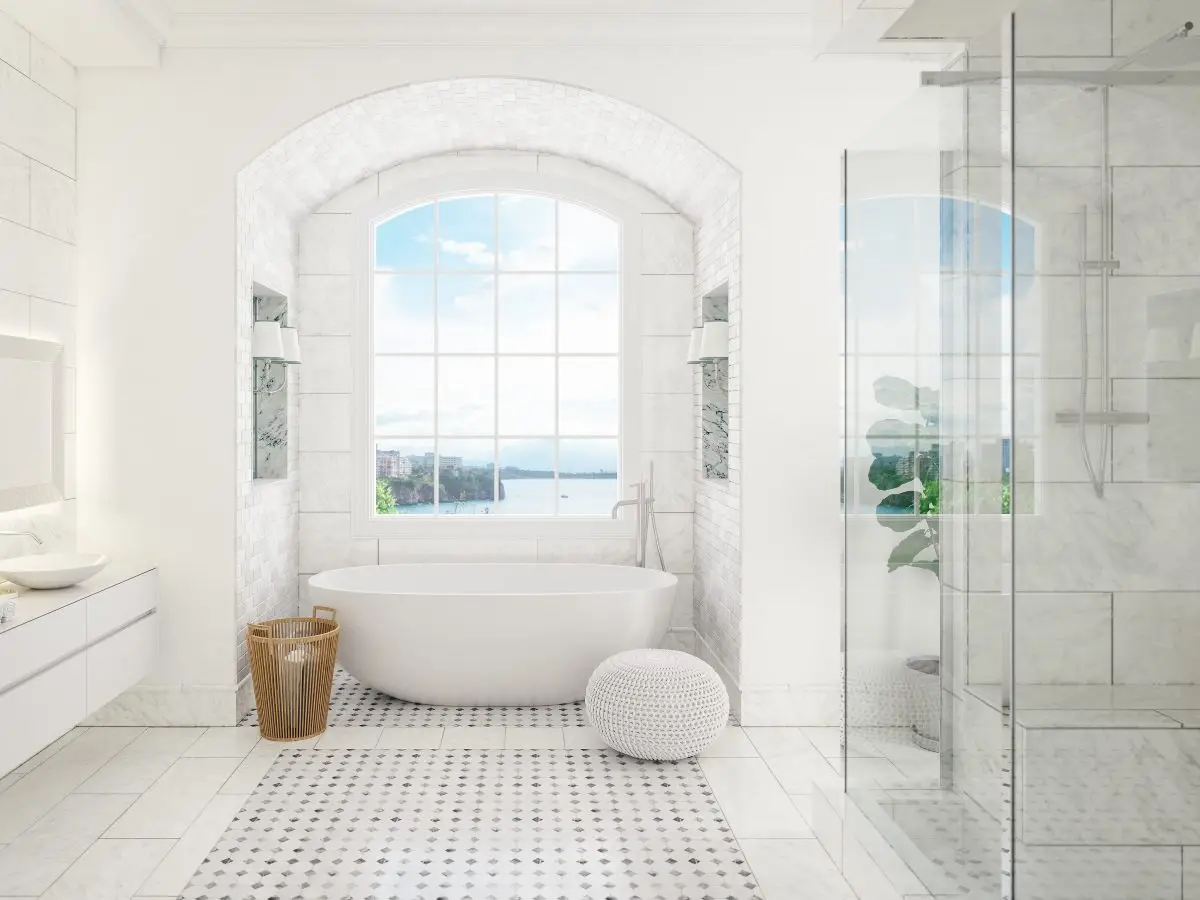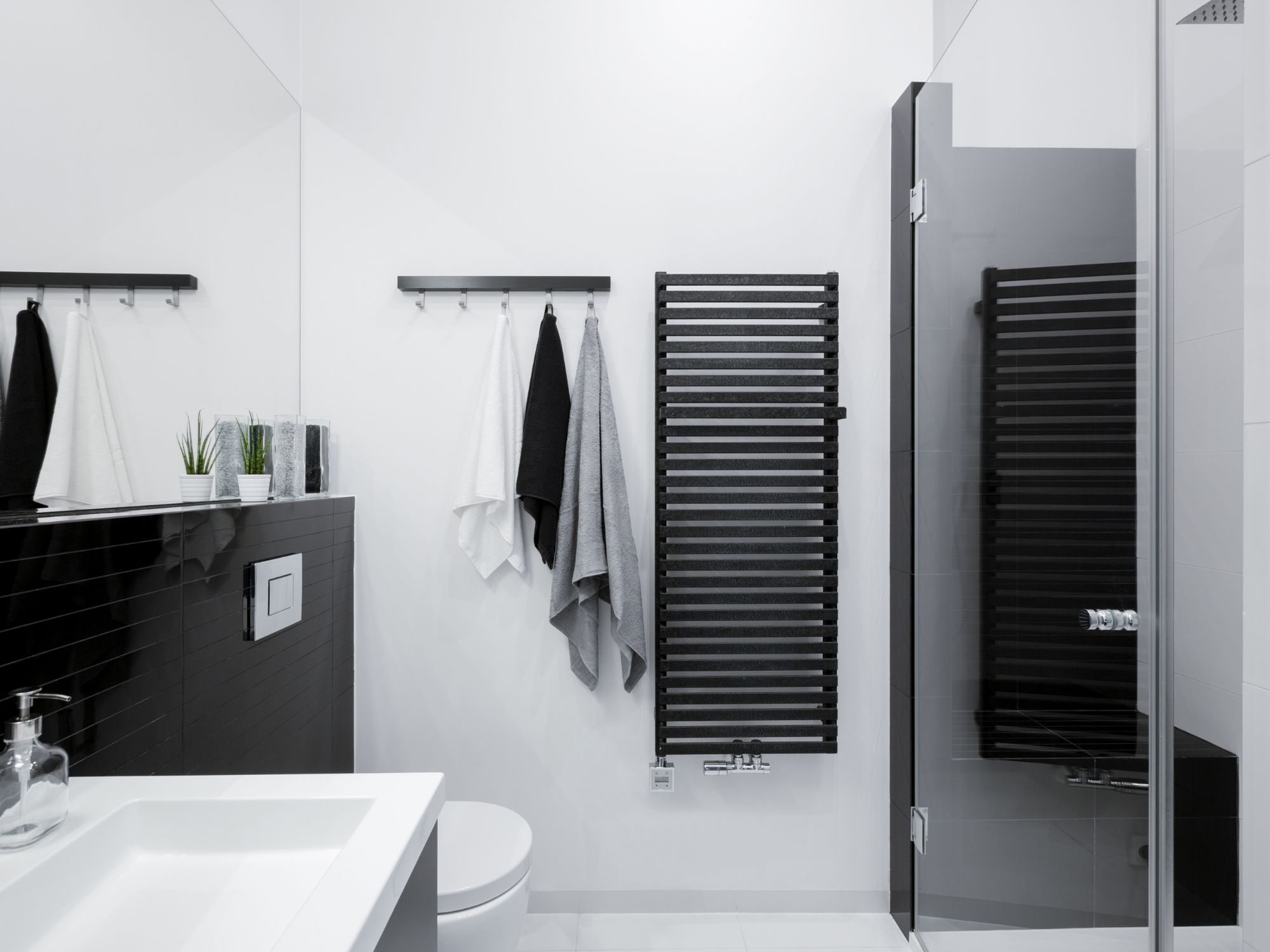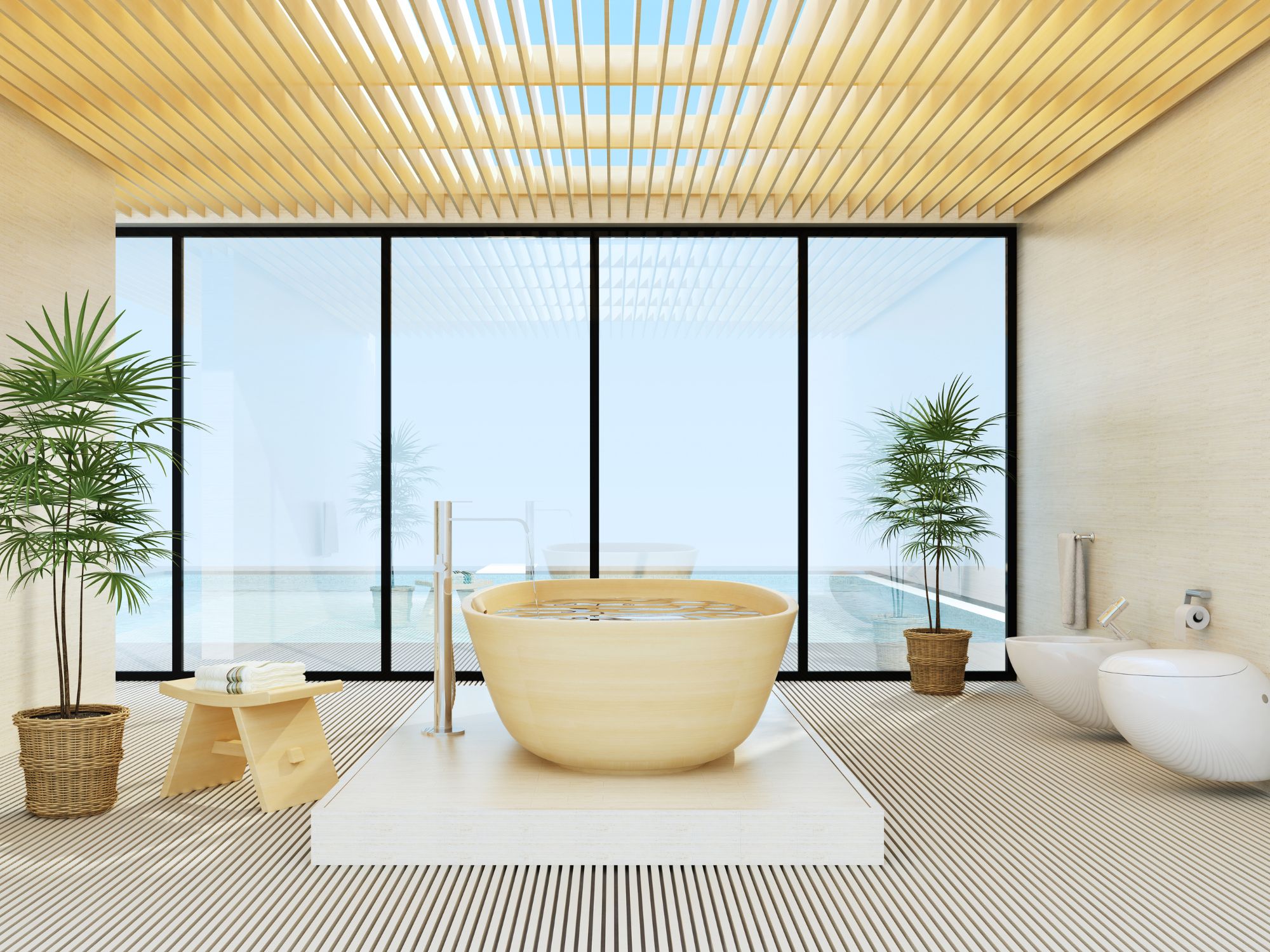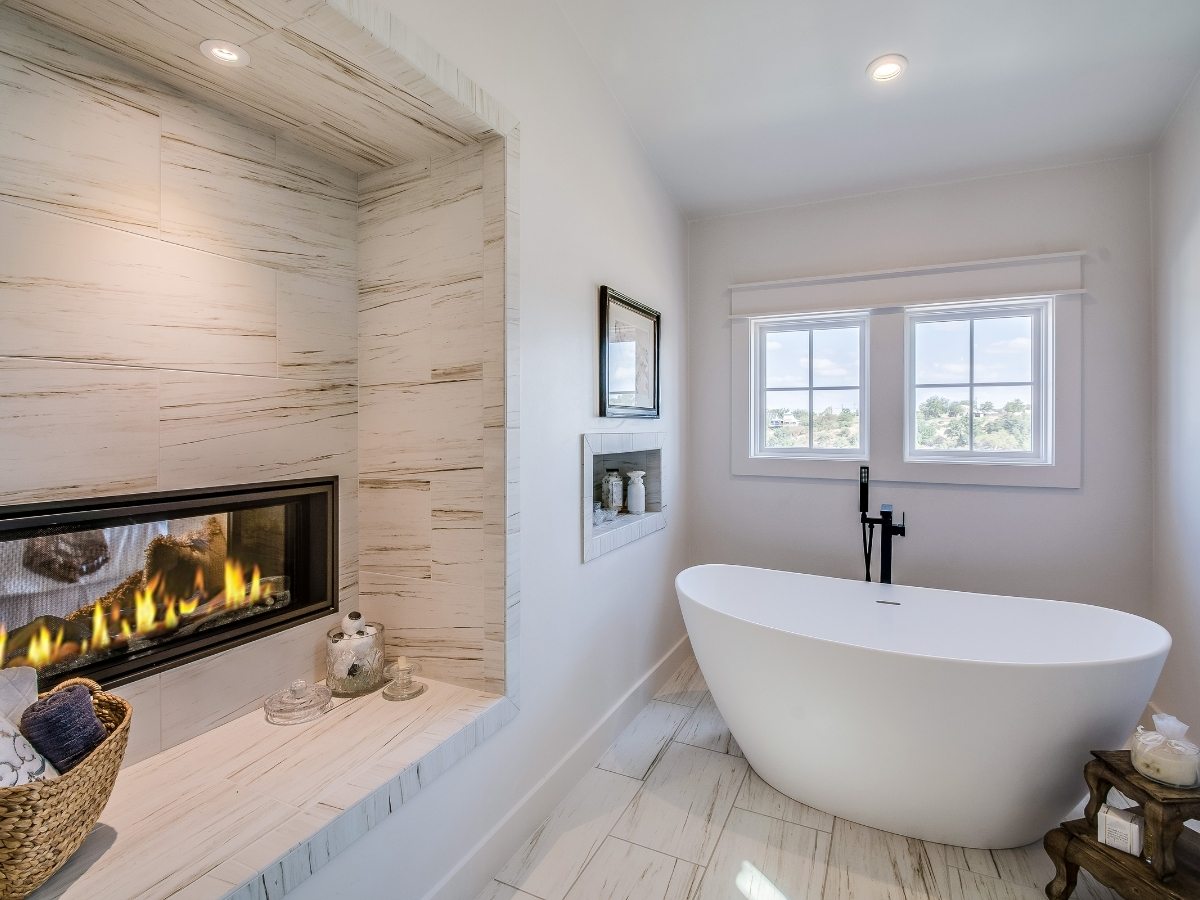This post may contain affiliate links which means I may receive a commission for purchases made through links at no cost to you. I only recommend products that I have personally used or curated specifically after reviewing and ensuring its quality! Learn more on my Private Policy page.
1. Heated Bathroom Floors
The thought of stepping onto cold tiles on a chilly morning can be daunting. Adding heated floors, or underfloor heating systems, have emerged as a coveted solution, offering not just warmth but also redefining luxury in modern spaces.
In this article, we will explore various aspects of bathroom floor heating systems, from electric floor heating to the energy-efficient hydronic systems, and whether they are a worthwhile investment for your home. Here is a list or manufacturers of each type of floor heating.
2. Types of Bathroom Heated Floors Systems
When considering installing heated floors in your bathroom, the two primary options are electric and hydronic systems. Electric floor heating elements involves installing electric heating cables beneath your existing flooring, turning the entire floor into a radiant heat source.
This system is easier to install and is ideal for smaller spaces or retrofit projects. On the other hand, hydronic systems use hot water circulated through pipes under the floor to generate heat.
Though more complex to install, they can be more energy savings, especially in larger areas or entire homes.
Electric Heated Floor Tiles
Electric heating, a popular choice for modern homes, involves the installation of electric heating cables beneath bathroom floors to generate heat. This system is known for its ease of installation, making it ideal for retrofitting as well as new constructions.
Benefits include uniform heating, the absence of cold spots, and the ability to control temperature via a thermostat to set the ideal temperature. It’s particularly suited for a room where installing extensive heating systems like hydronic setups is impractical.
Electricity heating is efficient and can be a cost-effective solution for heating smaller areas, providing the luxury of stepping onto a warm floor, especially during cold mornings.
Pros: Easier and less expensive to install, especially in smaller spaces. Offers quick heating and precise temperature control. Cons: May increase electricity usage; can be costly to operate in larger spaces.
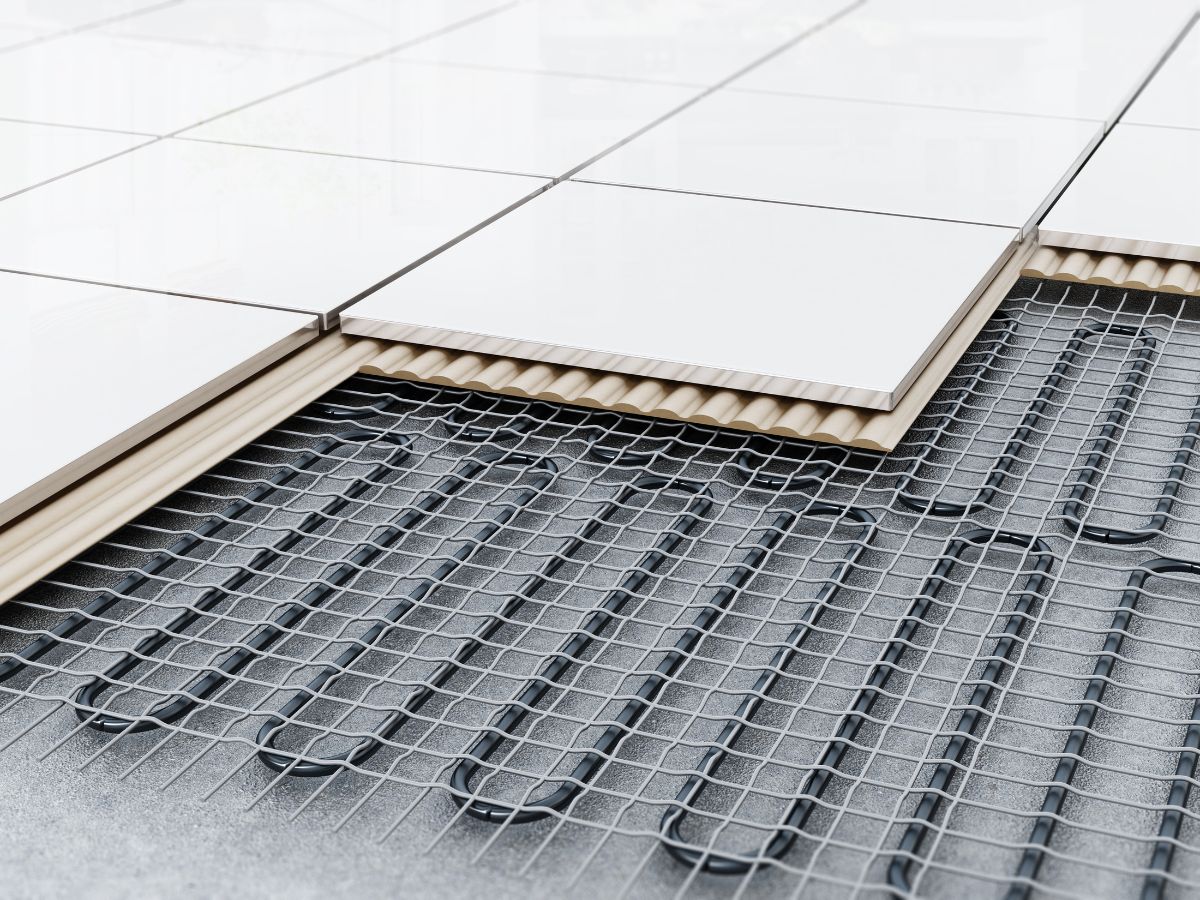
Hydronic Heated Floor System
Hydronic heating systems circulate hot water through pipes installed under the bathroom floors, creating radiant heat. This heating is typically connected to a boiler or water heater and is ideal for larger-scale installations or whole-house heating solutions.
Hydronic heating provides an even distribution of heat and is highly efficient, making it a preferred choice for those looking to heat larger spaces or multiple rooms.
The install process, however, is more complex and requires significant room for components like pumps and pipes, making it more suited for new constructions or major renovations.
Pros: More heat-efficient for larger spaces and can be cost-effective over time. Provides consistent and uniform heat. Cons: Installation is complex and expensive; requires a water heater. Not ideal for small-scale or retrofit projects.
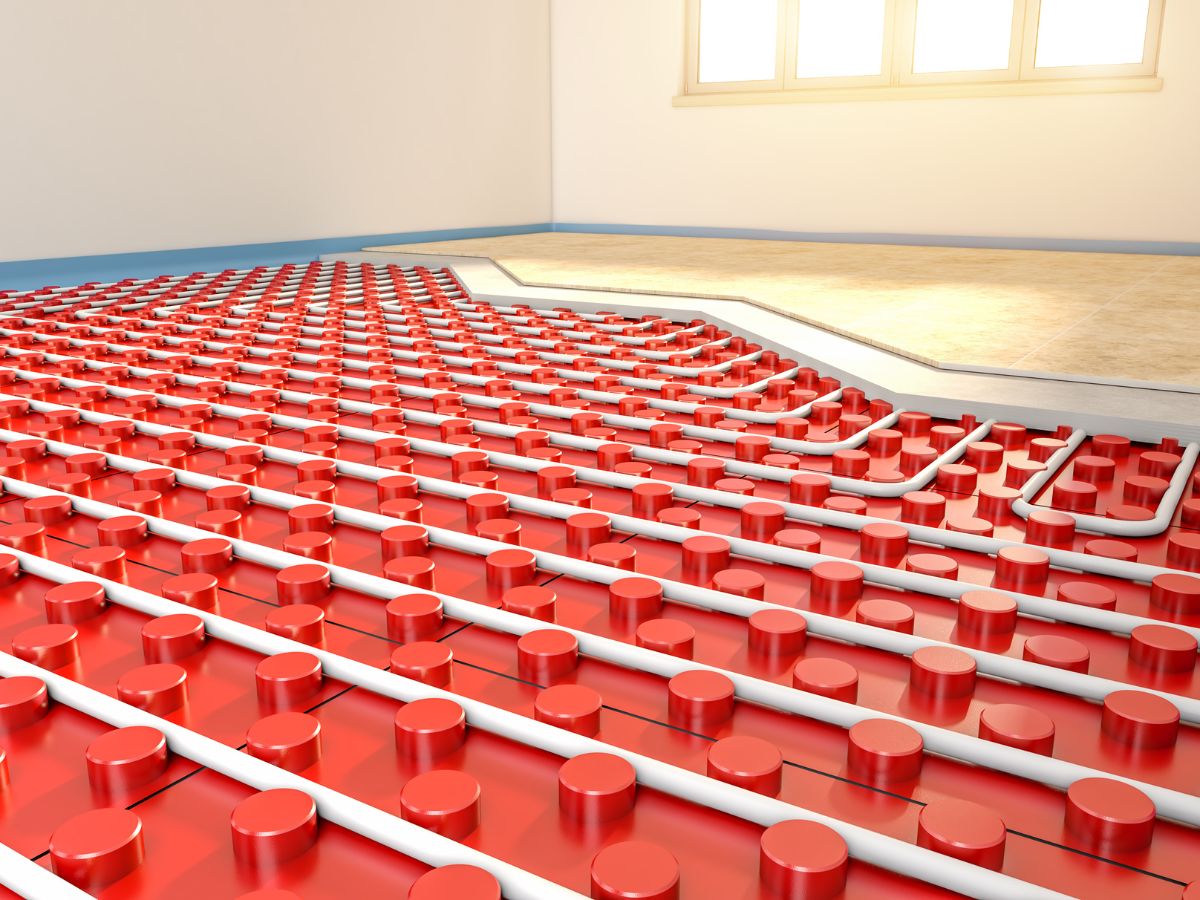
Infrared Floor Heating
A cutting-edge addition to floor heating options, infrared systems work by emitting infrared light which heats objects directly rather than warming the air. This method is highly efficient and can be installed under various types of flooring.
It’s particularly effective in promoting healthy living environments by reducing dust circulation and allergens.
Pros: Energy-efficient; promotes a healthier environment by reducing allergens. Cons: Relatively new to the market, which might limit availability and immediate familiarity among installers.
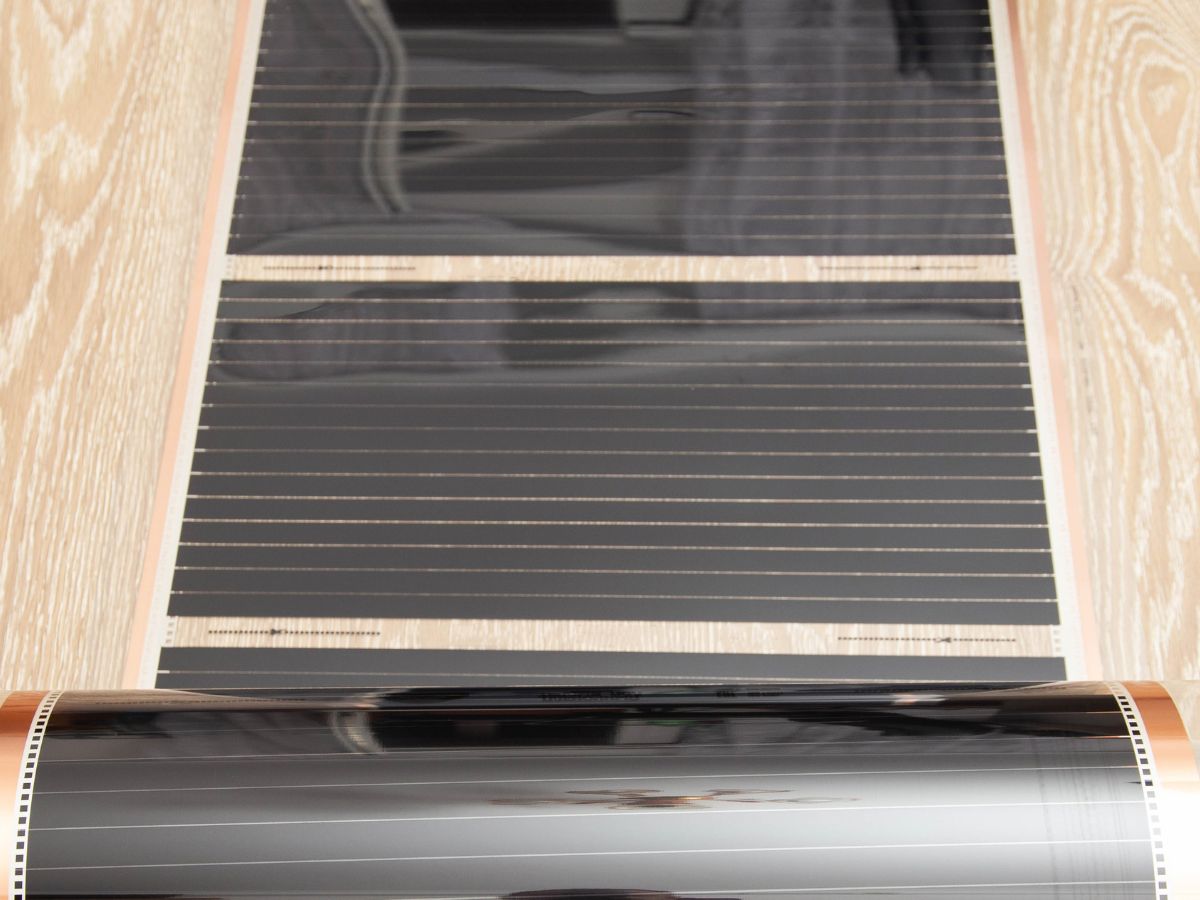
3. Styles and Shapes of Heated Floor Elements
Heated flooring options include mats and individual heating cables. Mats are easier to install and provide heating, ideal for standard-shaped rooms. Heating cables offer more flexibility and can be custom-fitted to rooms with unique layouts.
The choice between these depends on your bathroom’s size, shape, and the type of flooring you have.
Mats vs. Cables
Heated bathroom floors typically comes in two forms: mats and cables. Heating mats are pre-spaced, mesh-like structures that offer a convenient, heating solution, ideal for standard-sized bathrooms.
They are easier to install as the layout is predetermined. A heating cable approach, on the other hand, provide more flexibility and can be customized to fit irregularly shaped areas or to navigate around fixtures. Both forms effectively warm the floor but vary in complexity and adaptability to a unique space.
Layout Patterns
The layout pattern of the heat elements plays a crucial role in achieving optimal heat coverage and efficiency. For heating mats, the pattern is pre-set and covers a defined area uniformly.
With heating cables, the layout can be customized, allowing for targeted heating in specific zones of the bathroom.
Properly designed layouts ensure that there are no cold spots and the heat is distributed evenly across the entire floor surface, contributing to overall efficiency and comfort.
Customization Options
Customization is a key aspect of heating, especially when dealing with unique bathroom layouts. Heating cables offer the versatility to tailor it to fit around bathroom fixtures and in spaces of all shapes and sizes.
This flexibility ensures that the entire floor area, regardless of its dimensions, receives consistent and adequate heat, enhancing the overall functionality and comfort of the bathroom.
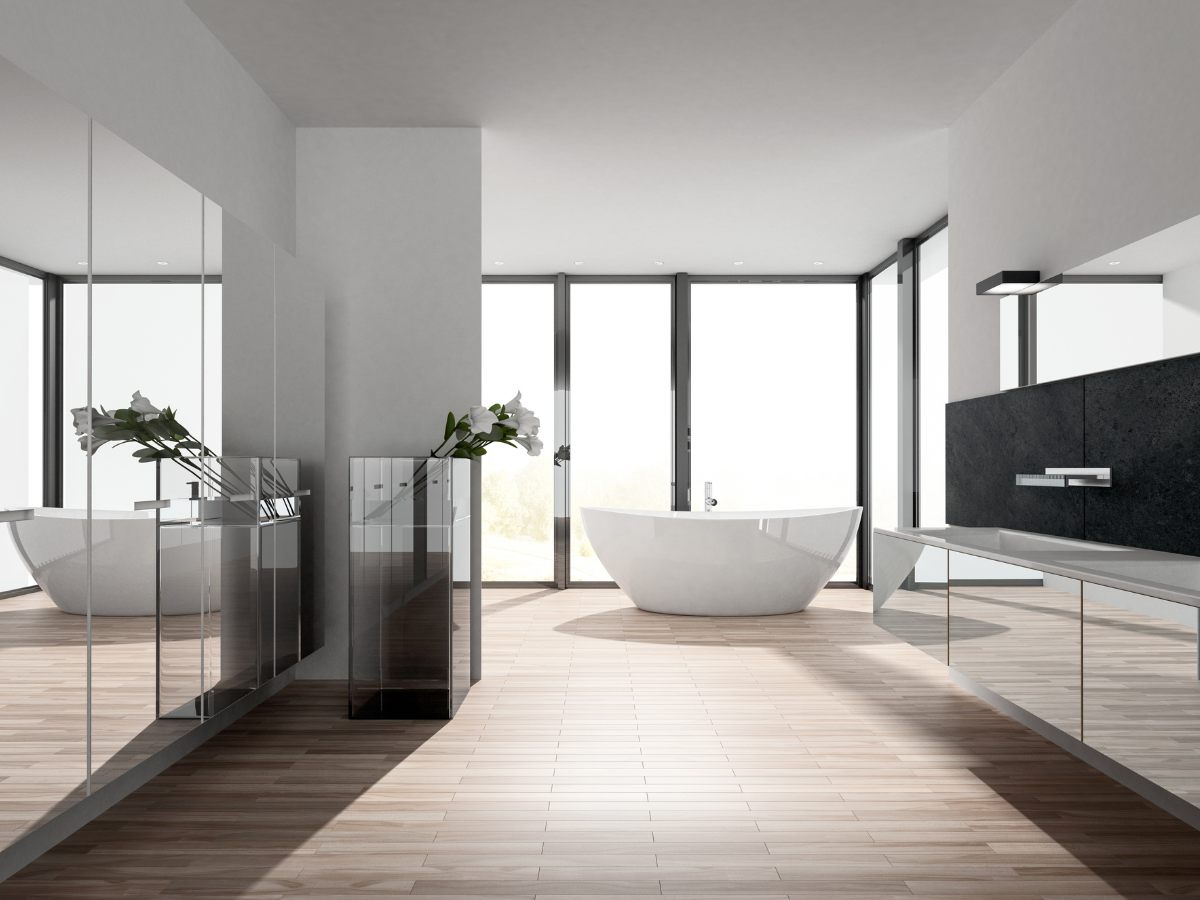
4. Bathroom Heated Floors – Smart Heated Floors Technologies
heated floors – Thermostats and Controls
Modern smart thermostats for floor heating systems offer advanced temperature control options. These thermostats can be programmed to heat the floor to the desired temperature at specific times, offering both comfort and efficiency.
Some models also come with features like Wi-Fi connectivity, enabling remote control through smartphones or tablets. This level of control allows users to adjust settings on-the-go, ensuring the bathroom is warm when needed and conserving energy when it’s not.
heated floors – Integration with Home Automation Systems
Heating can seamlessly integrate into smart home ecosystems, offering enhanced convenience and control. This integration allows users to manage their bathroom’s heating along with other home systems like lighting and security through a central hub or smartphone app.
You can set routines or use voice commands to control the heating, making it an intuitive part of the modern smart home experience.
Energy Management Features
Smart heating systems come equipped with energy management features that monitor and help reduce energy consumption. These systems can learn the user’s heating preferences and adjust accordingly, ensuring efficient use of energy.
Features like usage tracking and energy consumption reports provide insights that can help users optimize their heating settings to balance comfort and efficiency. These smart capabilities contribute to a more environmentally friendly and cost-effective heating solution.
Smart Floor Heating Technologies
Advancements in technology have brought smart features to heated bathroom floors. Modern systems come equipped with programmable thermostats, allowing you to schedule heating for specific times.
Some can even be controlled remotely via a smartphone app, adding to the convenience. This not only ensures a warm floor when you need it but also enhances efficiency by reducing unnecessary heating.
5. Heated Bathroom Floors – Safety and Convenience Features
Safety is paramount in bathroom heating systems. Most electric and hydronic systems come with waterproof components and are designed to minimize the risk of electrical hazards.
Additionally, features like automatic shut-off and temperature limits ensure that the floor doesn’t overheat, providing peace of mind alongside warmth.
heated floors – Built-in Safety Mechanisms
Modern bathroom floor heating systems come equipped with built-in safety mechanisms like automatic shut-off and temperature limits to prevent overheating. This is crucial in a bathroom setting where the combination of heat and moisture could pose risks.
These features ensure that the heated floors operate within safe parameters, providing peace of mind along with warmth.
Waterproofing and Durability
In the moist environment of a bathroom, waterproofing is essential for any heating system. Durable materials and robust construction protect against water damage, ensuring longevity.
This is particularly important for systems installed beneath tile or stone flooring, where any leakage or moisture penetration could be detrimental.
User-Friendly Interfaces
Ease of use is a key consideration in bathroom floor heating. Modern systems often come with user-friendly interfaces, including digital thermostats that allow easy control over temperature settings.
Some are even equipped with touch screens or can be controlled remotely, making it convenient to adjust settings for personal comfort.
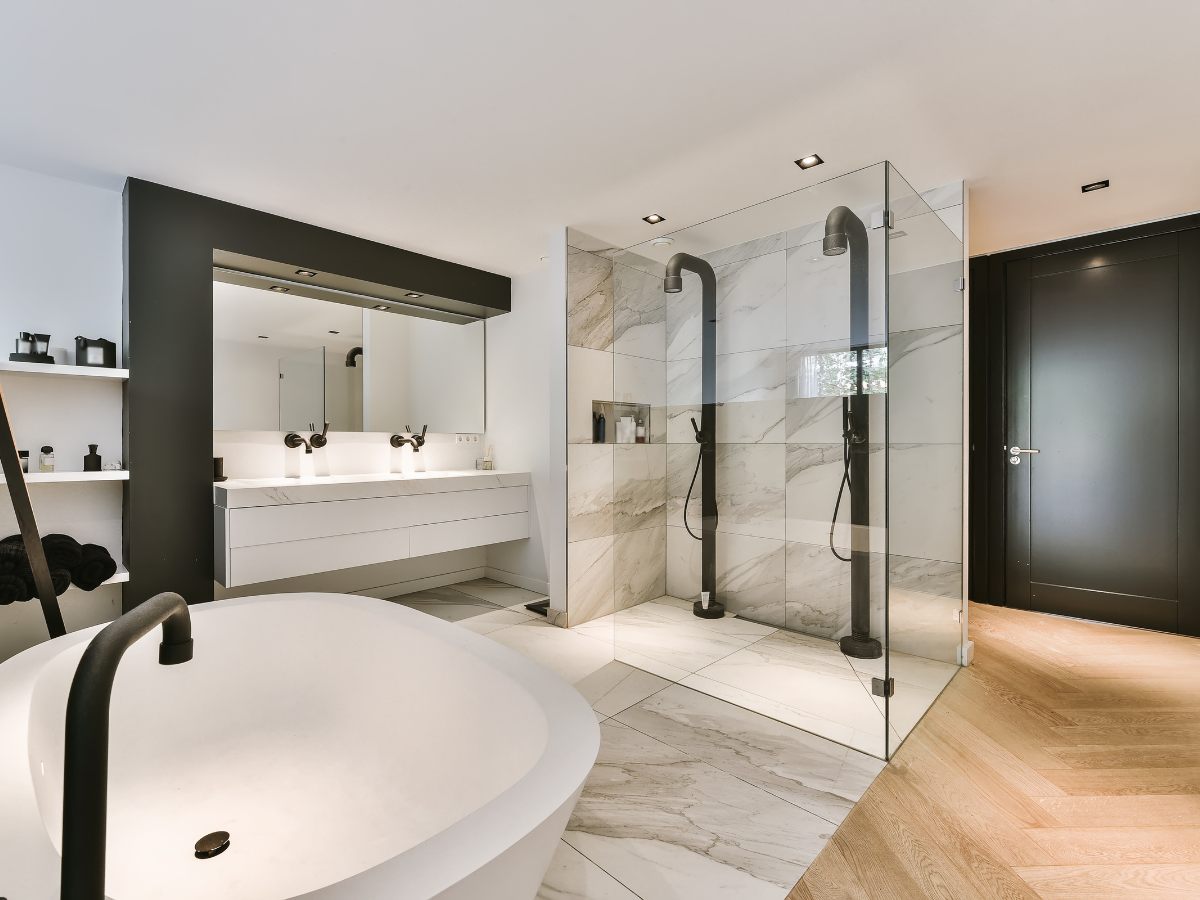
6. Bathroom Floors – Installation and Operational Convenience
The installation of heated floors varies based on the type of heating used. Electric and infrared systems offer DIY-friendly options, whereas hydronic installations typically require professional assistance. All systems benefit from minimal maintenance, with electric and infrared standing out for ease of upkeep.
Electric systems usually require less invasive installation and can be integrated with your existing flooring, making them a popular choice for remodels.
Hydronic systems, while more involved, are often installed during new constructions or major renovations. Operational convenience is a significant plus for these systems, as they require minimal maintenance once installed.
heated floors – DIY vs. Professional Installation
When it comes to installing bathroom floor heating, one can choose between DIY and professional installation. DIY kits are available for those who have some experience in home improvement, but professional installation is recommended for complex systems like hydronic heating to ensure proper and safe setup.
Maintenance Requirements
Maintenance requirements for bathroom floor heating systems vary. Electric systems typically require minimal maintenance, while hydronic systems might need periodic checks on boilers or water heaters. Proper installation and quality materials can reduce the need for frequent maintenance.
Operational Cost
The cost-effectiveness of operating a floor heating system is an important consideration. Electric systems might have a higher cost per square foot compared to hydronic systems, but the latter often have lower operational costs, especially if integrated into a home’s existing heating system.
Efficiency and the size of the heated area will play significant roles in determining the overall cost.

7. Heated Bathroom Floor Evolving Technologies
The world of heated bathroom floors is constantly evolving, with newer technologies focusing on energy efficiency and environmental sustainability.
Some systems now use renewable energy sources, and the latest models boast improved energy utilization, making them a more eco-friendly option than traditional heating methods like radiators or forced air systems.
Recent Innovations
The bathroom floor heating industry is continually evolving, with recent innovations focusing on improving heating efficiency and heat distribution. Advances include faster heating times, improved heat retention, and more uniform heating across the bathroom floor.
Sustainability Trends
Eco-friendly materials and energy-efficient technologies are becoming increasingly popular in bathroom floor heating systems. Across all types, innovations aim at improving energy efficiency and reducing environmental impact. Infrared heating, in particular, offers advantages by directly converting energy into heat with minimal loss, representing a leap forward in sustainable home heating.
Smart Floor Heating Technologies
Modern floor heating systems, especially electric and infrared, integrate seamlessly with smart home technologies. Programmable thermostats, Wi-Fi connectivity, and compatibility with home automation systems enhance operational convenience, energy efficiency, and user comfort.
Future developments in radiant floor heating systems technology might include even more advanced integration with smart home systems, greater heating efficiency, and the use of cutting-edge materials that offer superior heating performance and sustainability.
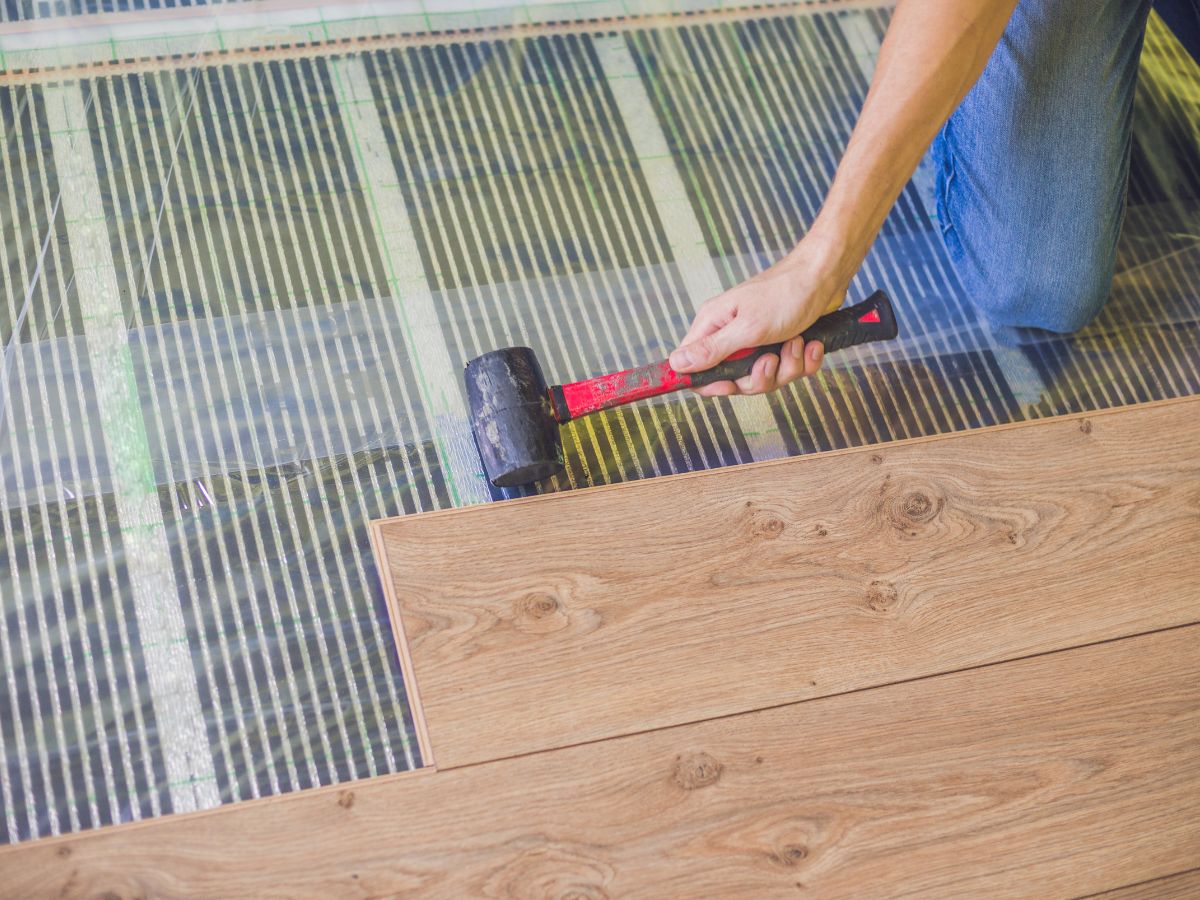
8. Selecting the Right Heated Bathroom Floor System
Choosing the right floor heating system for your bathroom involves a careful consideration of various factors such as the bathroom’s size, the feasibility of installation, and the impact on the environment. Hydronic, electric, and infrared heating systems each offer unique benefits, catering to different needs and preferences, thus providing a range of options for homeowners looking to enhance their bathroom experience.
Electric floor heating systems
Electric systems are renowned for their ease of installation and flexibility, making them particularly suitable for smaller bathrooms or renovation projects where breaking up the floor is not feasible. They provide rapid heating and precise temperature control through thermostats, allowing for a cozy bathroom environment in minutes.
However, while electric systems can be more cost-effective upfront, their operational costs might be higher, especially if the bathroom is used frequently or if the system is intended to heat a large area.
Hydronic floor heating systems
These systems are ideal for larger spaces or homes where the heating system can be integrated into an existing boiler. The installation of a hydronic system is more complex and costly, but it offers unparalleled efficiency for continuous use, making it a cost-effective solution in the long term.
This system distributes heat more evenly and retains heat for longer periods, providing consistent warmth underfoot. Hydronic heating is also considered more environmentally friendly, especially if it can be connected to solar water heating systems, reducing the reliance on fossil fuels.
Infrared heating systems
Infrared systems represent the latest advancement in floor heating technology, offering an efficient and health-conscious approach. Unlike traditional heating methods that warm the air, infrared systems directly heat objects and people, resulting in immediate warmth and comfort.
This direct heating method is not only energy-efficient but also promotes a healthier living environment by reducing the circulation of allergens and dust.
Infrared systems are easy to install and maintain, with minimal environmental impact, making them an excellent option for those seeking sustainable home heating solutions.
When selecting a floor heating system, it’s essential to balance these factors with personal lifestyle, the intended use of the bathroom, and long-term sustainability goals. Whether you prioritize quick heating, energy efficiency, or environmental sustainability, there’s a floor heating solution that can meet your needs, transforming your bathroom into a haven of warmth and comfort.
heated floors –Assessing Needs and Preferences
Choosing the right system involves considering the bathroom size, flooring type, and heating preferences. Assess whether the primary goal is luxury, efficiency, or a combination of both. For smaller bathrooms, electric units might be sufficient, while larger spaces might benefit from the efficiency of a hydronic system.
Comparing Options
When evaluating different systems, compare their energy efficiency, heated bathroom floor cost, installation requirements, and compatibility with your existing bathroom setup. Consider both upfront installation costs and long-term operational expenses. The table below provides a summary comparison of each floor system.
heated floors – Future-Proofing Your Choice
Select a system that will remain efficient and effective in the long term. Consider potential changes in your living situation and advancements in heating technology. Choosing a heated floor unit can adapt to future upgrades in your bathroom will ensure lasting comfort and value.
Table 1 – Floor Heating Types, Operations and Maintenance
| Factor | Electric Floor Heating | Hydronic Floor Heating | Infrared Floor Heating |
|---|---|---|---|
| Installation Cost | Moderate, suitable for retrofitting and new installations | Higher, primarily for new constructions or major renovations | Variable, can be DIY for certain products but may require professional for optimal placement |
| Operational Cost | Higher compared to hydronic, but efficient for smaller areas | Lower, especially when connected to an efficient heat source | Low, due to direct heating objects rather than air, reducing wasted energy |
| Maintenance | Minimal, with no moving parts | Requires maintenance for the boiler and pump system | Minimal to none, similar to electric systems, with no water components to maintain |
| Installation Time | Quick, often completed within a day for smaller areas | Longer, best suited to new construction or major remodels | Fast and straightforward, particularly for plug-and-play mat systems |
| Suitability | Ideal for any room size, especially effective under tiles | Best for whole-home systems or large bathrooms | Effective for all sizes, with health benefits due to reduced circulation of air and allergens |
| Energy Source | Electricity | Water heated by gas, oil, or electricity | Electricity, converting energy directly into infrared radiation |
| Heating Method | Radiant heat through coils | Warm water circulates through pipes | Infrared waves directly heat objects and bodies |
9. Manufacturers of Floor Heating Systems
| Heating Type | Manufacturer | Website |
|---|---|---|
| Infrared | WarmlyYours | warmlyyours.com |
| Heatscope | heatscope.com | |
| Hydronic | Uponor | uponor-usa.com |
| Warmboard | warmboard.com | |
| Electric | Nuheat | nuheat.com |
| SunTouch | suntouch.com |
10. Heated Bathroom Floors – Conclusion
Heated bathroom floors offer a touch of luxury while also being a practical addition to your home. They not only provide the comfort for all kind of floors including tiles, wood, marble, stone – but can also contribute to the overall heating of the bathroom space, making cold mornings more bearable.
With advancements in technology and increasing options for energy efficiency, investing in a heated floor for your bathroom can be worth it, both for the immediate comfort and potential long-term savings.
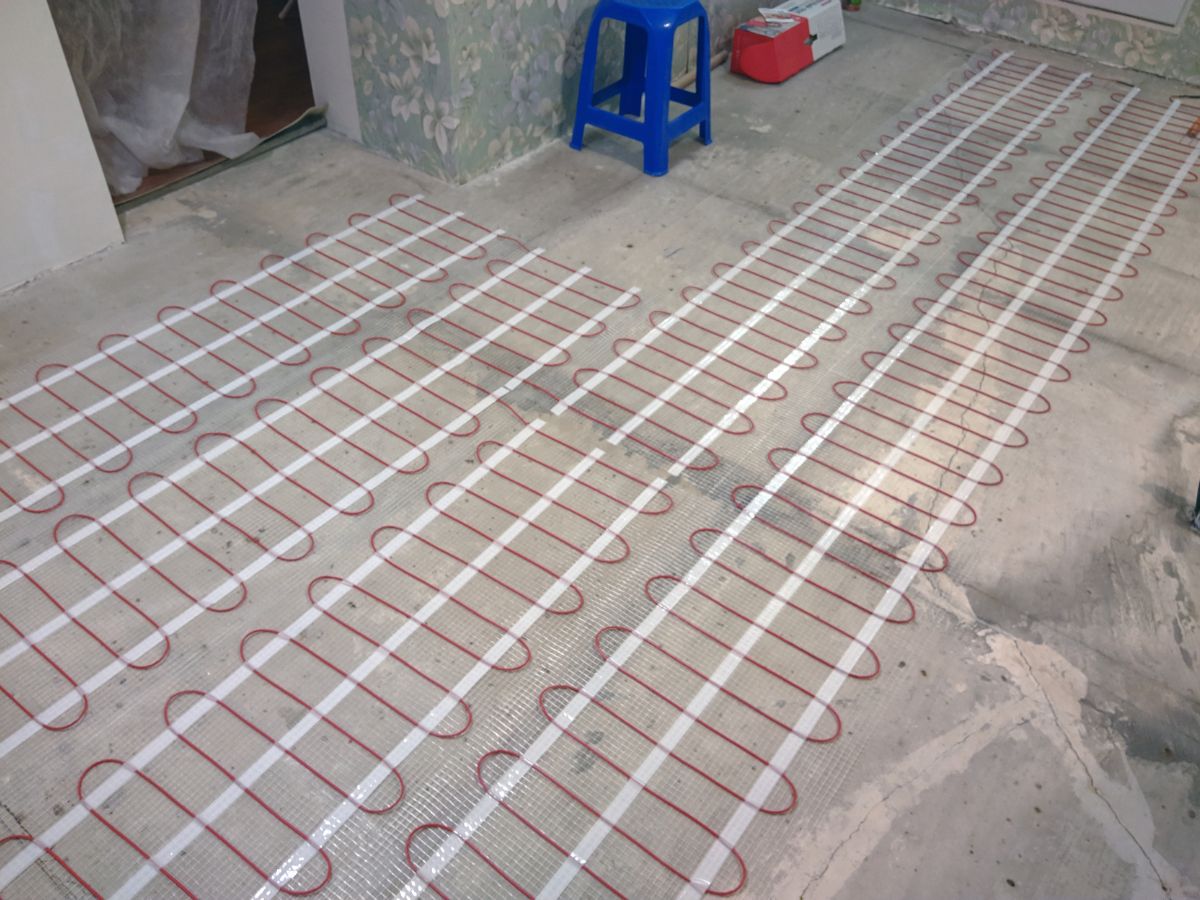
11. Frequently Asked Questions
Heated floors in the bathroom can be worth it for many homeowners, as they provide comfort, warmth, and luxury, especially during colder months. They can also help to maintain a consistent temperature in the bathroom, reduce moisture, and create a cozy ambiance.
Yes, underfloor heating in a bathroom is generally a good idea. It eliminates the need for traditional radiators or space heaters, which can take up valuable space and may not distribute heat evenly. Underfloor heating provides gentle warmth from the ground up, ensuring comfort and preventing cold spots.
Heated bathroom floors can use electricity, but the amount varies depending on factors such as the size of the room, the type of heating system, and how often it’s used. While they may increase electricity usage slightly, they are generally considered efficient and cost-effective for maintaining warmth in the bathroom.
The best heating for a bathroom floor often depends on personal preference, budget, and the specific needs of the space. Common options include electric radiant heating systems, hydronic (water-based) systems, and heated floor mats or cables.
One cost-effective way to heat a bathroom is by using radiant floor heating. Electric mats or cables installed beneath the flooring provide efficient warmth without the need for ductwork or extensive renovations. Additionally, using programmable thermostats and optimizing insulation can help reduce heating costs.
The cost of heated floors in the bathroom varies depending on factors such as the size of the room, the type of heating system chosen, and installation complexity. Generally, electric radiant heating systems can range from a few hundred to a few thousand dollars, including materials and installation.
Some disadvantages of heated floors include initial installation costs, potential repair and maintenance expenses, and the possibility of increased energy consumption. Additionally, heated floors may not be suitable for all flooring types and may take longer to heat up compared to traditional heating methods.
The lifespan of a heated bathroom floor depends on factors such as the quality of the heating system, installation method, and maintenance. With proper care and maintenance, electric radiant heating systems can last upwards of 20 years, while hydronic systems can last even longer
Yes, heated floors can be installed on concrete substrates. Electric radiant heating systems can be embedded in thin-set mortar or installed beneath tile, stone, or other flooring materials directly on the concrete surface. It’s essential to follow manufacturer recommendations and ensure proper insulation to maximize efficiency.
While heated floors offer many benefits, they also have some disadvantages. These may include initial installation costs, potential repair and maintenance expenses, and the possibility of increased energy consumption.
Additionally, heated floors may not be compatible with all flooring types and may require adjustments to accommodate existing plumbing or wiring.
The lifespan of a heated bathroom floor can vary depending on factors such as the quality of the heating system, installation method, and usage. Electric radiant heating systems typically last 15-20 years or more with proper care and maintenance.
Hydronic systems, which use water-based heating, can last even longer, often exceeding 25 years. Regular inspections and maintenance can help prolong the lifespan of heated bathroom floors


